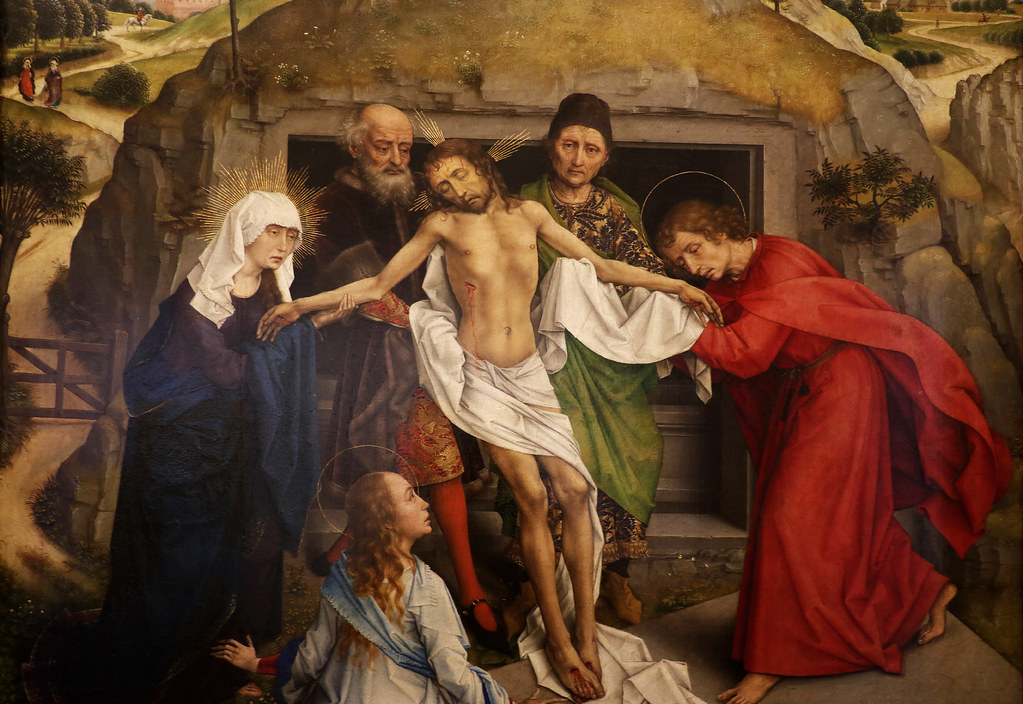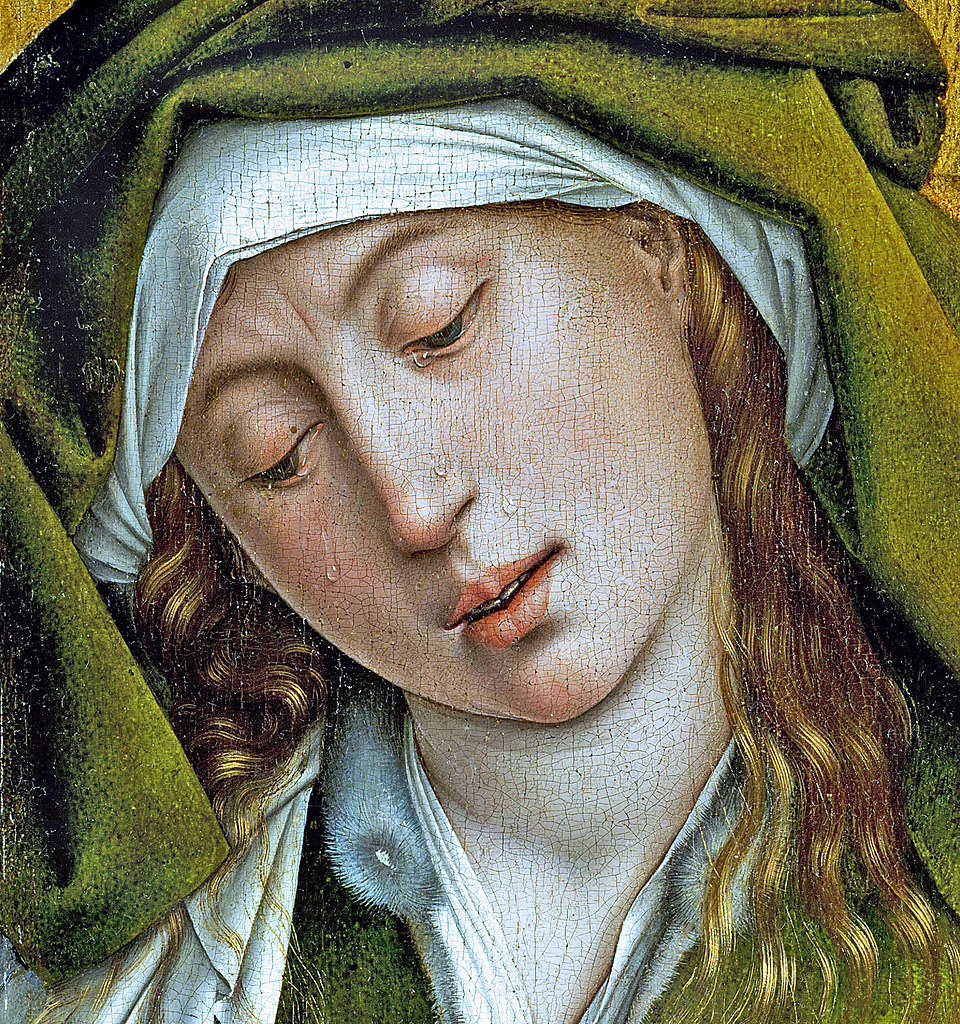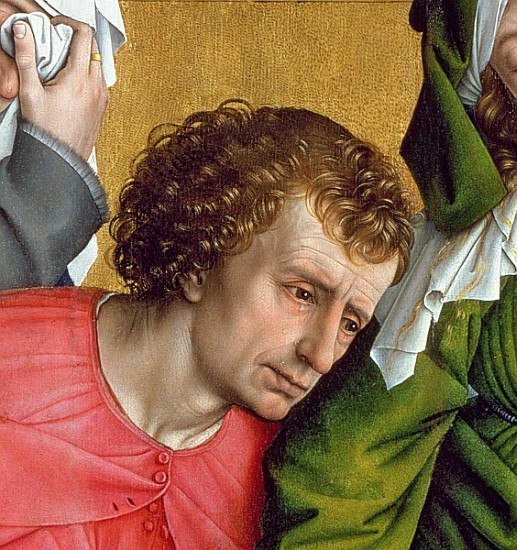
Deposition (detail3) c. 1435 Rogier van der Weyden
Campbell, Lorne, 'Rogier van der Weyden El Descendimiento' En:, Rogier van der Weyden y los reinos de la Península Ibérica,. Ferrarino, Luigi, La Deposizione dalla Croce di Roger Van der Weyden, Studium, pp. 548-555. Exhibitions + Reunited Madrid 06.06.2020 - 25.07.2021

Rogier van der Weyden, Detail from Descent from the Cross, 1435 St
Changing even very slightly a composition by Van der Weyden is inevitably dangerous and usually has destructive effects, which shows how carefully Rogier considered the placing of every line, every shape, every colour (Campbell, L.; Pérez Preciado, J. J.: Rogier van der Weyden, Museo Nacional del Prado, 2015, pp. 142-144).

Particolari di opere 3. Rogier van der Weyden Deposizione dalla Croce
The Legacy of Rogier van der Weyden. Rogier van der Weyden was one of the most influential artists of his time, along with his master, Robert Campin, and Jan van Eyck. These three painters shaped Northern Renaissance art most notably through the close observation and meticulously detailed representation of human figures and their surroundings.

La Deposizione del Prado di Rogier Van der Weyden Arte Svelata
The artist, a follower of Rogier van der Weyden, based this painting on Weyden's altarpiece, now in the Prado in Madrid. As Weyden did, this artist described faces, fabrics, and objects in great detail and arranged the figures as though in a frieze. The shallow space is further limited by the use of the gold-stippled background.

Rogier van der Weyden (Tournai 1399 Bruxelles 1464) De… Flickr
Rogier Van Der Weyden painted the Deposition from the cross. This remarkable painting is full of detail that Kelly explains so well. The painting was commissioned for an altarpiece for the Leuven Guild of Archers for their chapel. Many Art Historians consider it the most influential work of the 15th century, certainly one of the most dramatic.

La Deposizione del Prado di Rogier Van der Weyden Arte Svelata
Rogier van der Weyden. Rogier van der Weyden ( Dutch: [roːˈɣiːr vɑn dər ˈʋɛidə (n)]) or Roger de la Pasture (1399 or 1400 - 18 June 1464) was an early Netherlandish painter whose surviving works consist mainly of religious triptychs, altarpieces, and commissioned single and diptych portraits. He was highly successful in his lifetime.

La Deposizione del Prado di Rogier Van der Weyden Arte Svelata
Despite all the action and people participating in it - ten in all - Van der Weyden manages to create an atmosphere which is both convincing and intimate without a sense of crowdedness. Picture and description of a work by Rogier van der Weyden: The Deposition. Oil on panel (220 x 262 cm), dated 1435.

Rogier Van Der Weyden DEPOSIZIONE DI CRISTO 143335 —Huile 220 x
Weyden, Rogier van der. Tournai (Belgium), 1399 - Brussels (Belgium), 1464. Roger de le Pasture was born in about 1399 in Tournai, then one of the principal towns of France but an enclave in the territories of the dukes of Burgundy. He lived in Tournai and in Brussels, where his name was translated into Dutch as Rogier van der Weyden, and where.

Deposition, Descent from the Cross, Rogier van der Weyden, circa 1435
Rogier van der Weyden, (born 1399/1400, Tournai [Belgium]—died June 18, 1464, Brussels), Northern Renaissance painter who, with the possible exception of Jan van Eyck, was the most influential northern European artist of his time. Though most of his work was religious, he produced secular paintings (now lost) and some sensitive portraits.

Identidad sanjuanera El Descendimiento, Oleo sobre tabla de Roger Van
Deposition. c. 1435 Oil on oak panel, 220 x 262 cm Museo del Prado, Madrid. The earliest painting that can be ascribed to Rogier van der Weyden with any certainty is also the artist's greatest and most influential extant work: the great Deposition. It cannot have been painted very long after 1435, the year established by dendrochronological.

an image of a painting with people around it that is being taken from
Rogier Van der Weyden, Deposizione, 1435. Particolare. Le figure dei dolenti, assiepate intorno al Redentore, esprimono il proprio strazio con gesti eloquenti: la donna a sinistra, ad esempio, si copre il volto con le mani, come a voler nascondere alla vista la dolorosa realtà. Deposizione, 1435. Particolare. Rogier Van der Weyden, Deposizione.

El descendimiento
O riginariamente un trittico, la Deposizione dalla Croce di Rogier van der Weyden, dipinto tra il 1435 e il 1443 è l'unica parte sopravvissuta, tradizionalmente a un terribile naufragio durante lo spostamento dell'opera dai Paesi Bassi alla Spagna.Si tratta di un capolavoro assoluto, è difficile immaginare una rappresentazione più convincente e avvincente del dolore non solo nell'arte.

Rogier van der Weyden, The Last Judgment (detail), c. 144652
And from 20 September a major retrospective of Van der Weyden's works - there'll be at least 100 in all - will go on display at M, the newly refurbished municipal museum of Leuven. Alas, the.

Rogier Van Der Weyden LA DEPOSIZIONE DALLA CROCE YouTube
Rogier van der Weyden depicts the moment when Joseph of Arimathea, Nicodemus and another person hold Jesus' body and Mary faints into the arms of Saint John the Evangelist and the holy women. The large-dimensioned figures are all dressed with precious materials. The blue color used in Mary's robe is a pure lapis lazuli rarely found.

Rogier Van Der Weyden DEPOSIZIONE DI CRISTO 143335 —Huile 220 x
Interpretation of Descent From the Cross by Roger van der Weyden. One of the greatest religious paintings of the Flemish school, The Descent from the Cross (Deposition of Christ) by Roger van der Weyden depicts the crucified Christ being lowered from the cross.It is the earliest painting that can be safely attributed to Van der Weyden - dendrochronological (tree) analysis dates it to around.

Rogier van der Weyden YouTube
Rogier van der Weyden, The Crucifixion, with the Virgin and Saint John the Evangelist Mourning, c. 1460, oil on panel, 71 x 73-3/8 inches / 180.3 x 186.4 cm (Philadelphia Museum of Art). Created by Beth Harris and Steven Zucker. Questions. Tips & Thanks.